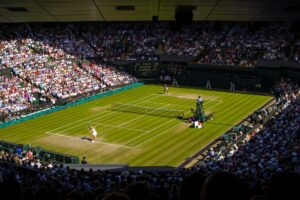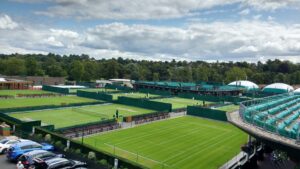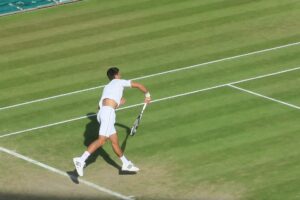Wimbledon serves up less waste
Around half a million fans head to Wimbledon each year for 13 days of dramatic tennis action. During that time thousands of tons of waste are produced – from food and drink, to packaging, tennis strings, balls, and more. It’s enough to give nearby neighbours The Wombles plenty of work for another year.
Changes have been made over recent years to significantly cut the amount of waste generated and ensure as much as possible is recycled. But is Wimbledon really as green as its grass courts?
Discover how and why Wimbledon started to ace its waste reduction and sustainability aims.

Setting sustainability targets
The All England Lawn Tennis Club (AELTC) – which organises Wimbledon – set out a ten-year sustainability plan for the championships in 2020. In its own words, this is for Wimbledon:
“To act as a force for good, delivering a positive and sustainable impact on our economy, society and the environment in support of the UN’s Sustainable Development Goals.”
Wimbledon’s updated sustainability policy outlines four key aims, two of which relate to reducing waste by:
- Reducing emissions from its operations to ‘net zero’ by 2030
- Being a resource-efficient organisation by 2030
No love for waste
As set out in its sustainability plan, the end goal for Wimbledon is ‘to design out waste, keeping products in use so nothing goes to waste.’ Reducing resources, increasing recycling and reuse of waste are how it aims to achieve this.
Wimbledon doesn’t publicly publish its waste and recycling figures or have any specific waste reduction targets available to the public. However, in 2018, 2019, and 2021 it achieved zero-waste-to-landfill status and claims none of the waste generated from day-to-day business or the championships end up in landfill.
One of the ways it’s achieved this is by separating recyclable and general waste. While glass, paper, dry mixed recycling, and other types of recyclable rubbish was sent to be reused, general waste was collected and used to generate electricity for the National Grid. In 2019 this was enough to power 112 homes for a month.
That’s a lot better than it all ending up in landfill and adding to pollution problems. The same is true for the garden waste produced, which is used to create mulch for use around the grounds of Wimbledon too.

More than a match for food and drink waste
You’ve probably seen all the stats trotted out every year about how much food and drink are consumed at Wimbledon:
- 320,000 glasses of Pimms
- 190,000 sandwiches
- 166,000 portions of strawberries and cream
- 110,000 scones
- 75,000 ice creams
- 32,000 portions of fish and chips
- 28,000 bottles of champagne
- 25,000 pizzas
Sadly, not all this food and drink is consumed. But how much of it is wasted? There are no official statistics released by Wimbledon about its food waste. However, figures from 2015 show that 28 tons of food waste produced were recycled – that’s the same weight as four adult elephants.
The good news is food waste at Wimbledon is collected for anaerobic digestion. This means it’s used to produce high quality fertiliser for agriculture and horticulture purposes. Learn more about anaerobic digestion
Wimbledon has also partnered with City Harvest – a food redistribution platform. It works with 300 organisations to distribute in-date food leftover from Wimbledon to charities and community organisations across London, such as soup kitchens and women’s refuge centres.
Volleying away plastic and packaging
All that food and drink uses a lot of plastic cups, glasses, containers, and packaging. Wimbledon has made some significant changes in recent years to try and ensure as much as possible is reusable and avoid any going to landfill. These changes include:
- Handing out cold drinks in reusable, rigid plastic cups – not disposables. Fans should return them to dedicated points for washing.
- No plastic straws are available anywhere at Wimbledon.
- For the early risers or those trying to stay awake through a mammoth five-set thriller, the 330,000 coffee cups used each year are also recyclable.
- Strawberries and cream are served in plastic-free cardboard boxes. These are completely recyclable and made using 100% certified card.
- In 2021 Wimbledon got rid of plastic liners for food trays for the first time.
Players play their part
On court there have also been recent changes for the players to try and make Wimbledon as green as the grass they play on. Stringer’s plastic bags that protect newly strung rackets were removed, while all used racket strings are now collected and sent for recycling. In 2022 there’s also a returns process for staff uniforms to avoid clothes waste going to landfill.
One area that’s less green is the use of water bottles by players. It’s mainly due to sponsorship and, while they’re made from 100% recycled materials, for players that take in a lot of fluids during a match, larger reusable bottles surely make more sense.

No new balls please
More than 50,000 tennis balls are used each year at Wimbledon. Why so many? They’re changed every nine games, so players don’t use flat, damaged balls. This means a lot of partly used tennis balls are no longer needed at the championships again.
Thankfully, they’re not thrown away – as tennis balls don’t really biodegrade and contain various chemicals that could leach into nearby water and ground if sent to landfill. Instead, they’re sold at the used ball kiosk so fans can take home a souvenir and reuse them.
In 2001 they were even donated to the wildlife trust in Avon, Glamorgan and Northumberland, to use as nests to protect endangered harvest mice from predators.
Building a greener future
One area where work still needs to be done is with construction. While Wimbledon impressively claims it diverts more than 95% of major project construction waste from landfill, some such waste that may be reusable still ends up underground. With proposals for the AELTC Wimbledon Park Project at the consultation stage, this is a key area.
Wimbledon claims to have achieved a 95% waste diversion from landfill rate in this area but is working to update design requirements for estate development projects. This should improve recyclability and see Wimbledon procure more recycled materials.
Wimbledon has also set itself future waste reduction targets, including to:
- Introduce water harvesting for new developments
- Design reusable or recyclable products using renewable, recyclable materials
- Work with suppliers to eliminate single-use plastic packaging
- Introduce on-site composting for grass and garden cuttings
Hopefully Wimbledon will smash these targets to eliminate waste entirely from its annual championships.
Waste collection in Wimbledon and the UK
Our waste collection services cover everywhere from Wimbledon to Whitby. Whatever type of waste you need removing and recycling, call us on 0800 211 8390 or complete our free quote form below to get started.
Have your waste collected
Get a fast FREE quote for your waste collection 0800 211 83 90
- Free quote within 1 hr
- Any type of waste
- FREE bins and delivery
- We cover all of the UK